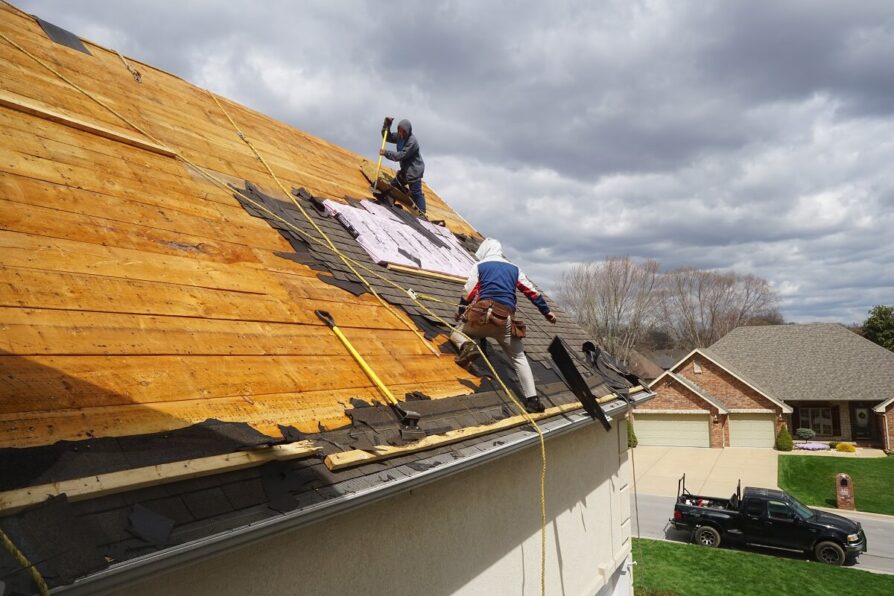Roof installation is a comprehensive process that requires careful planning, precision, and expertise to ensure a durable and reliable roofing structure. Here is an overview of the typical roof installation process used by a reputable roofing contractor.
Assessment and Planning – Roof Installation Process
The initial assessment and planning stage is the foundation of a successful roof installation project. This phase involves a thorough evaluation of the existing roofing structure or architectural plans for new construction. A roofing contractor takes into account factors such as the type of roofing material, slope, climate considerations, and local building codes. The assessment guides decisions on the most suitable roofing system, ensuring it aligns with the property’s specific needs and aesthetic preferences.
Removal of Existing Roofing
A roof tear-off is a crucial phase in roof replacement projects, involving the complete removal of the existing roofing materials down to the roof deck. This process is essential to assess the condition of the deck, address any underlying issues, and prepare a clean and stable surface for the new roofing system. Roofing professionals carefully strip away the old shingles, underlayment, and flashing, ensuring that all remnants of the previous roofing are properly cleared. A roof tear-off ensures that the new roofing system can be installed on a solid foundation.
Repair and Preparation
Repair and reinforcement are often necessary during roof installation to ensure the structural integrity and longevity of the new roofing system. During the removal process, issues such as rot or weakened roof deck sections are identified. Repairing these issues is essential to create a solid foundation for the new roof. Additionally, reinforcement may be needed to strengthen areas that will bear additional weight, such as those supporting heavy roofing materials or equipment. By addressing these concerns proactively, roofing professionals ensure that the newly installed roof is both durable and resilient, providing reliable protection for years to come.
Installation of Underlayment
A roof underlayment is a vital component of a roofing system that provides an extra layer of protection between the roof deck and the final roofing material, such as shingles or tiles. Typically made from waterproof materials like synthetic fabric, felt, or rubberized asphalt, the underlayment acts as a barrier against moisture infiltration. It plays a crucial role in preventing water from seeping into the roof deck, which could lead to rot, mold, and structural damage over time.
Installation of Flashing and Drip Edges
Flashing and drip edges are pivotal elements in a roofing system, serving as key safeguards against water infiltration and structural damage. Flashing, typically made of metal or weather-resistant materials, seals vulnerable areas like roof penetrations to prevent leaks and water seepage. Drip edges, installed at roof edges, guide water away from fascia and roofing materials, preventing moisture-related issues and maintaining the integrity of the roof’s foundation.
Installing Roofing Materials
Installing roofing materials involves carefully placing and securing the chosen roofing components onto the roof deck according to the manufacturer’s specifications. The process may include laying down underlayment, fastening shingles, tiles, or other roofing materials in an overlapping pattern, and ensuring proper alignment and coverage. Skilled roofing professionals use precise techniques to ensure a watertight and weather-resistant finish that not only enhances the aesthetics of the property but also provides reliable protection against the elements.
Ventilation and Insulation
These are crucial factors in roof installation, ensuring both the comfort and longevity of a building. Proper ventilation allows air to circulate within the attic space, preventing moisture buildup that could lead to mold growth and structural deterioration. Insulation, on the other hand, helps regulate indoor temperature, minimizing heat loss in colder months and heat gain in warmer months. Together, these elements create a balanced environment that promotes energy efficiency, prevents damage, and contributes to a healthier and more comfortable living space.
Ridge Cap Installation
A roof ridge cap is a specialized roofing component designed to cover the peak or ridge of a sloped roof. It is typically made of the same material as the roofing, such as shingles or tiles, and is installed to provide a protective barrier against water infiltration and to create a finished appearance. The ridge cap plays a crucial role in sealing the highest point of the roof, helping to maintain the roof’s overall weather resistance.
Final Inspection
The final inspection is a pivotal stage in a roofing project, marking the culmination of the installation process. Conducted by both roofing professionals and homeowners, this comprehensive assessment ensures that every aspect of the roofing system meets the required standards. From the integrity of the roofing materials to the precision of the installation, no detail is overlooked. Any potential issues or deviations from the project’s specifications are identified and addressed during this inspection, providing a final opportunity to make necessary adjustments before concluding the project.
Clean-Up and Debris Removal
Cleanup after a roofing project is a vital component of ensuring a seamless and satisfying completion. Experienced roofing contractors understand the significance of leaving the work site in pristine condition. They meticulously remove debris, including discarded materials, nails, and other waste, to prevent potential hazards and maintain the property’s appearance. Thorough cleanup also extends to the surrounding areas, ensuring that no debris has spread to neighboring properties or landscapes.
Final Walkthrough
The final walkthrough of a roofing project is a critical step that signifies the completion of the installation process. This phase involves a comprehensive inspection conducted by both the roofing contractor and the homeowner. During the walkthrough, all aspects of the project are carefully reviewed to ensure that the roofing system meets the desired quality, functionality, and aesthetic standards. The final walkthrough provides an opportunity for the homeowner to assess the finished roofing system, ensuring that it aligns with their expectations and specifications.
Installing a roof is a complicated, multi-step process that will yield better results when it is performed by a qualified roofing contractor. From assessing the job prior to work getting underway to meeting with the property owner to address any final concerns, each step requires an in-depth knowledge of roofs, materials, and the ability to communicate effectively with property owners.
Peak Roofing & Exteriors
If you’re looking for an honest and experienced roofing contractor that can handle your home or business roofing needs in West Texas, look no further. Peak Roofing & Exteriors will deliver with quality and integrity. Contact us today and book your FREE inspection!

